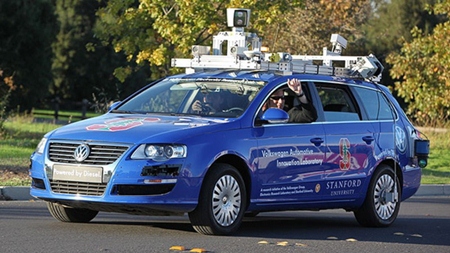The technology is here now! Self driving cars are reality. And if you don’t believe me, talk to the owner of a new Ford Focus, a car which parallel parks itself after you select reverse and take your hands off the steering wheel. Not a gimmick – it does it perfectly every time, after the car measures the space to park in and away you go!
I was at a lecture the other day (Automotive Focus Group) and the Thomas Chambers MD of Continental mentioned the coming era of driverless motor cars. I remember that probably 30 years ago, Continental was experimenting with driverless cars, which followed a cable buried in the roadway.
 Automated Passat.
Automated Passat.
Jeevan Vasagar, a journalist based in the UK, experienced being passenger in a driverless car, a modified Volkswagen Passat. This vehicle was devised by a team at the Free University of Berlin, and their Passat is a highly advanced autonomous car, which it is claimed is capable of navigating a safe path through unpredictable city traffic.
This Passat has a spinning silver cylinder mounted on the roof, a laser scanner, which generates a million data points per second to give the car’s computer a real-time map of its surroundings.
Cameras and radar sensors provide further detail, alongside an ultra-precise GPS based on the navigation systems used in aircraft. According to Jeevan, it will be many years before a car this sophisticated is commercially available, but Germany’s luxury car makers have begun introducing a number of autonomous features that enable some of their leading models to drive and steer themselves.
Daimler, which owns Mercedes-Benz, predicts that at low speeds – such as in traffic jams or parking – cars will operate with full autonomy “in a matter of years”. At higher speeds, several manufacturers plan for highly automated driving within the structured environment of a motorway.
The latest Mercedes S-Class is the most significant advance yet in automated driving for the mass market. The luxury sedan comes equipped with a camera that scans the road ahead and an array of radar sensors. The images it captures are analyzed by an algorithm, allowing the car to alert the driver to danger and take corrective action itself if necessary.
“In critical situations, the driver assistance systems in the car react more quickly than humans ever could,” says Professor Ralf Herrtwich, director of driver assistance at Daimler. “Unlike drivers, they are never inattentive.”
The aim of greater automation is not to take away the pleasure of the open road but to save motorists from some of the tasks that make driving a chore.
Raul Rojas, a professor of artificial intelligence at the Free University of Berlin who leads its autonomous car project, predicts the public transport of the future will be fleets of robot taxis, cheaper and safer than the human kind, operating for 24 hours a day without fatigue.
In a few years time, Professor Rojas suggests, people will use their mobile phones to summon a robot taxi, dropping it off at their destination ready for the next passenger.
There are still technical barriers to the mass production of automated cars. The key problem is vision. The laser scanners used by the Free University’s car cannot pass through a solid barrier, so a pedestrian stepping out from between two parked buses would be invisible until the last moment.
An automated car “does not just need to watch out for other cars”, Professor Herrtwich says. “It needs to check for pedestrians and cyclists, for lanes, stopping lines, traffic signs, and traffic lights. It needs to understand that a lane ends in a few hundred meters or that there is a stalled vehicle on the highway ahead of it.”
It goes without saying that this technology does not just need to be reliable, but affordable within the budget constraints of a typical mass production vehicle.
The Free University’s team is working on improving the computer’s vision, but face a huge challenge replicating the human ability to see.
“Almost a fifth of the brain is just for image processing,” Professor Rojas says. “Computer visual recognition is still very, very primitive.”
One vital question is legal liability, as a BMW spokeswoman says, “Who is responsible for an automated driving system in case of an accident or failure?”
So there are many questions still unanswered, and human reluctance to hand over the “reins”, is just one of them.




